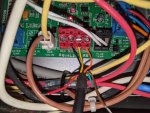I'm not interested in shelling out for a pool controller and this is a fun project for me. Also, I have Hayward products mixed with Jandy so I think DIY would be my only option anyways. I find it amazing that all these devices have rs485 communications for their features and yet the codes to control them seem to be closely guarded trade secrets (judging from the takedown request for AqualinkD by Jandy).
ajohnson30 and Mutley have posted amazing programs that developed in these threads:
https://www.troublefreepool.com/threads/control-your-jandy-equipment-from-your-pc-with-a-15-adapter.27391
and Aqualink PDA automation using RS485
Unfortunately, all of these are efforts to communicate with a pool controller that in turn controls the slave devices. I see that Mutley started the AquapureD project to communicate directly with a SWG which is a great start... but without a controller to send commands to the pump or heater I don't have a way of reverse engineering their commands the same way. I know this is essentially what the Autelis products are doing, but their website says they are shut down for covid and they are not known for sharing that sort of info.
I'm at the point where i've identified the heater's device id as 104 (0x68) and it responds to a probe with an ACK. I'm trying to brute force out command numbers to see what flies but i've had no luck getting a response. Has anyone here monitored the commands and responses between the controller and slave devices? Mutley, did you ever work with a heater or pump?
The controller sends <header><device id><command><arguments><footer>. Header, device id, and footer are easy enough... and the set commands SHOULD be very simple. For example with the SWG setting the % is command 17 (or 0x11) and an argument value between 1 and 100. In theory, the heater temperature should be the same, just a different command number and presumably a temperature in farenheit. I imagine with the pump there is a command that selects the different speed presets. I figure i can deduce the responses to these commands in time. From there it's easy to integrate all of this into web controls and IoT data. Then Jandy can hate me too.
Has anyone else gone down this path?
ajohnson30 and Mutley have posted amazing programs that developed in these threads:
https://www.troublefreepool.com/threads/control-your-jandy-equipment-from-your-pc-with-a-15-adapter.27391
and Aqualink PDA automation using RS485
Unfortunately, all of these are efforts to communicate with a pool controller that in turn controls the slave devices. I see that Mutley started the AquapureD project to communicate directly with a SWG which is a great start... but without a controller to send commands to the pump or heater I don't have a way of reverse engineering their commands the same way. I know this is essentially what the Autelis products are doing, but their website says they are shut down for covid and they are not known for sharing that sort of info.
I'm at the point where i've identified the heater's device id as 104 (0x68) and it responds to a probe with an ACK. I'm trying to brute force out command numbers to see what flies but i've had no luck getting a response. Has anyone here monitored the commands and responses between the controller and slave devices? Mutley, did you ever work with a heater or pump?
The controller sends <header><device id><command><arguments><footer>. Header, device id, and footer are easy enough... and the set commands SHOULD be very simple. For example with the SWG setting the % is command 17 (or 0x11) and an argument value between 1 and 100. In theory, the heater temperature should be the same, just a different command number and presumably a temperature in farenheit. I imagine with the pump there is a command that selects the different speed presets. I figure i can deduce the responses to these commands in time. From there it's easy to integrate all of this into web controls and IoT data. Then Jandy can hate me too.
Has anyone else gone down this path?



